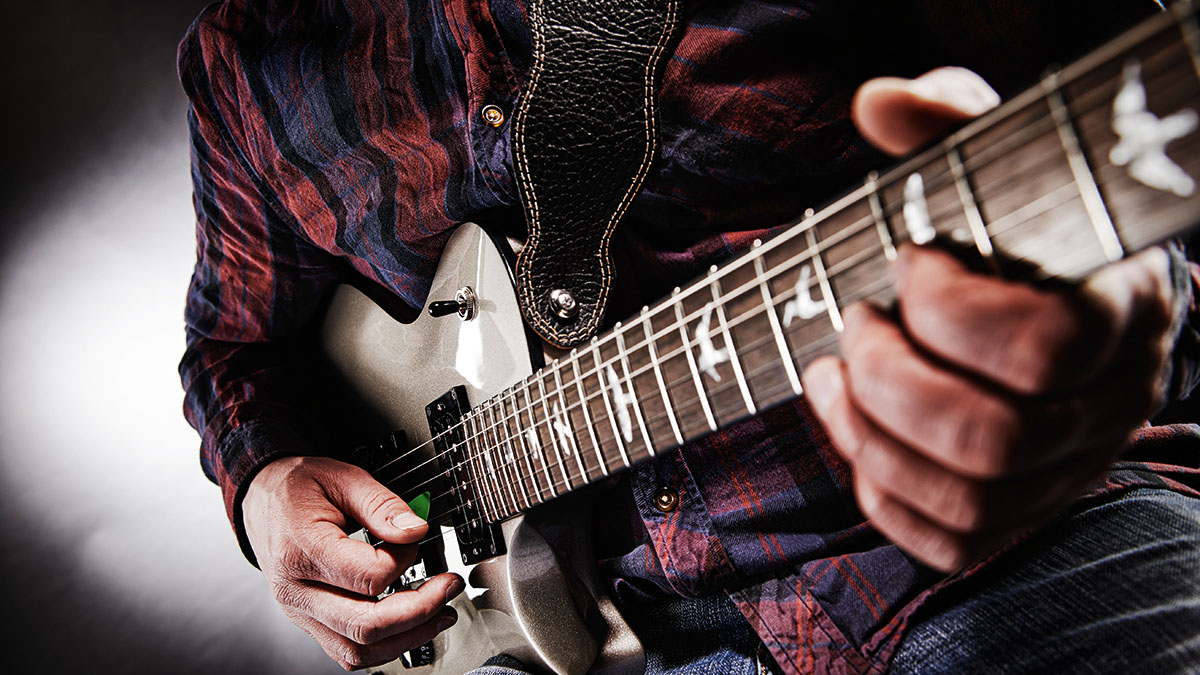
An arpeggio is the notes of a chord played one at a time. On guitar, arpeggios have a reputation for being used mainly in jazz and shred solos. While they are great tools for advanced soloing, they are useful in every style of guitar.
Classic riffs like The Killers’ Mr Brightside, Aerosmith’s Same Old Song And Dance, and REM’s Everybody Hurts are built around arpeggios. In fact, there’s so much you can do with them that for this lesson we’re only looking at one type of arpeggio: the minor 7. You may hear about techniques like sweep picking, string skipping, economy picking, or tapping for arpeggios. They’re cool, but you don’t need them here.
The notes in a minor 7 arpeggio are the first, third, fifth and seventh notes from a natural minor scale – giving the intervals: root, b3rd, 5th, b7th. You might notice that’s similar to the minor pentatonic scale (root, 3rd, 4th, 5th, 7th). You can think of a minor 7 arpeggio as a minor pentatonic scale with the perfect 4th left out. And because you probably already know at least one pentatonic shape, it’s easy to find convenient minor 7 shapes.
You might think reducing the number of notes you can play is a strange way to make your lead playing more interesting, but soloing with a minor 7 arpeggio sounds surprisingly different from the pentatonic. Your ear is used to hearing that 4th note, and you’ll notice its absence. Switching between minor 7 and pentatonic ideas can add variety to solos.
Arpeggios are also great for rhythm parts, either on their own or as a second part while another guitar plays chords. The same idea can work in completely different genres depending on what tone you use: a clean, jangly tone can really enhance an indie track, while using palm muting and gain could make the same part work in a rock or metal song.
Example 1. Write riffs with minor 7 chords

The similarity of the minor 7 arpeggio to the minor pentatonic scale makes it great for all the situations where you could use the pentatonic but want something slightly different. Here’s one way you could play a heavy riff using only the minor 7.
Example 2. Use them in blues licks

A simple place to start is playing an ascending arpeggio as an approach to a pentatonic blues lick. This example plays a two-octave arpeggio for the first two beats and then shifts into shape four of the minor pentatonic scale.
Example 3. Minor 7th open-string jangle

Mixing fretted and open notes is very effective. The notes in Am7 are A-C-E-G, so you have three open strings available in standard tuning; Em7 (E-G-B-D) gives you five possibilities. For other keys, try different tunings or a capo.
Example 4. Make simple chords sound clever

Theory time: Cmaj9 has the notes C-E-G-B-D, and Am11 is A-C-E-G-B-D, so they each contain all the notes of an Em7 chord. If the band plays a simple C major (C-E-G) or Am (A-C-E), adding Em7 over the top will give the sound of these beautiful extended chords.
Example 5. Add colour to powerchords

Here’s how the concept from example 4 could work in context: the backing plays basic C5 and A5 powerchords. By playing a melody with the notes of Em7 over the top, you create the effect of Cmaj9 and Am11.







